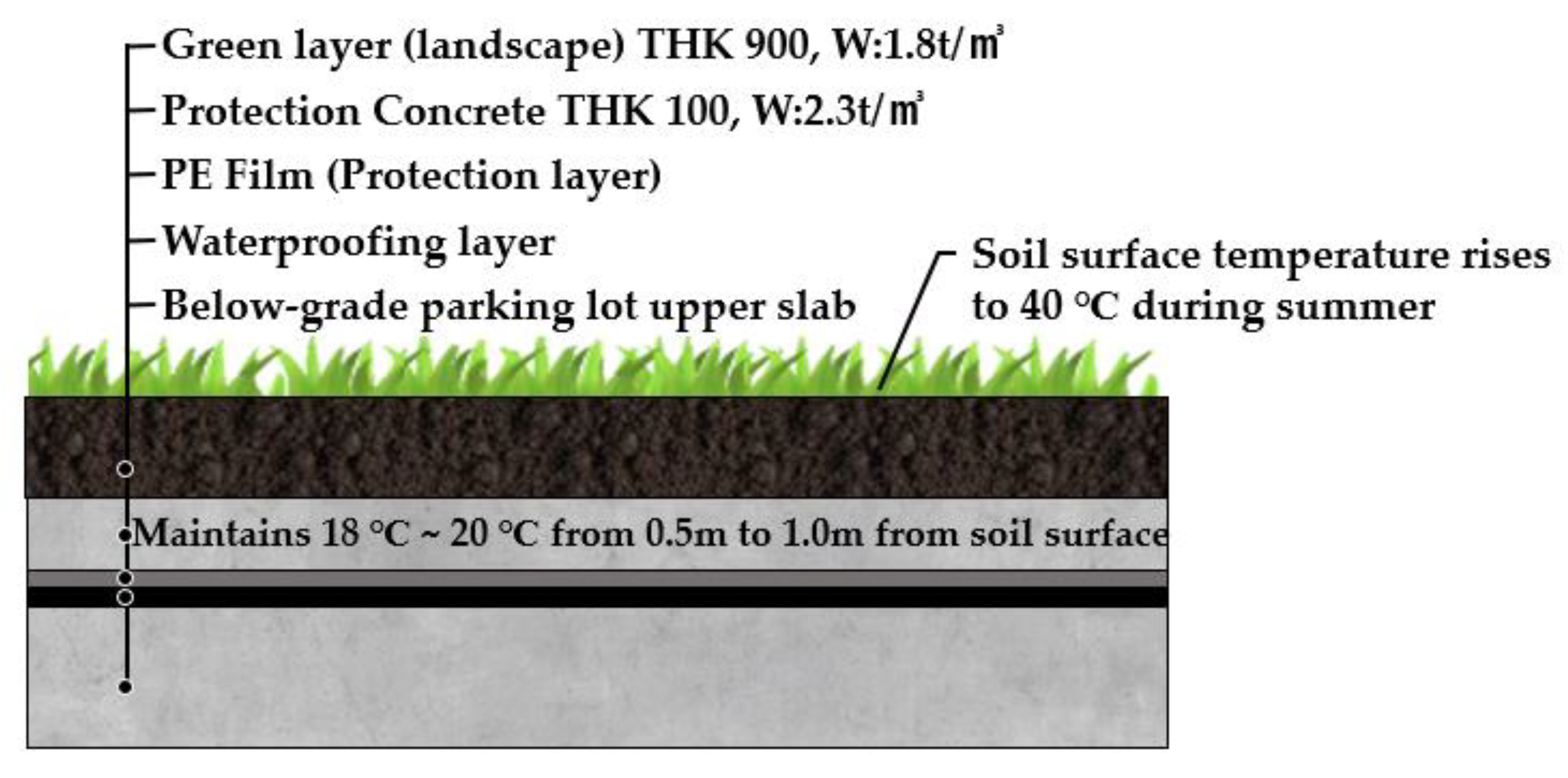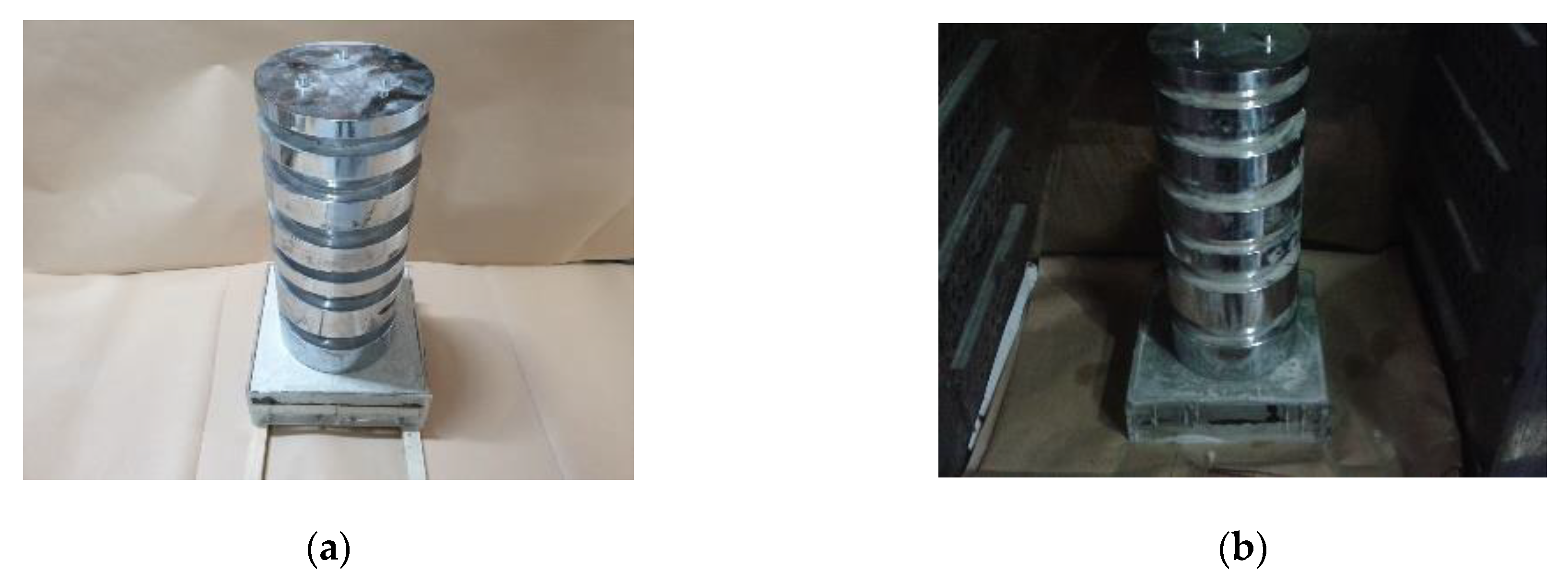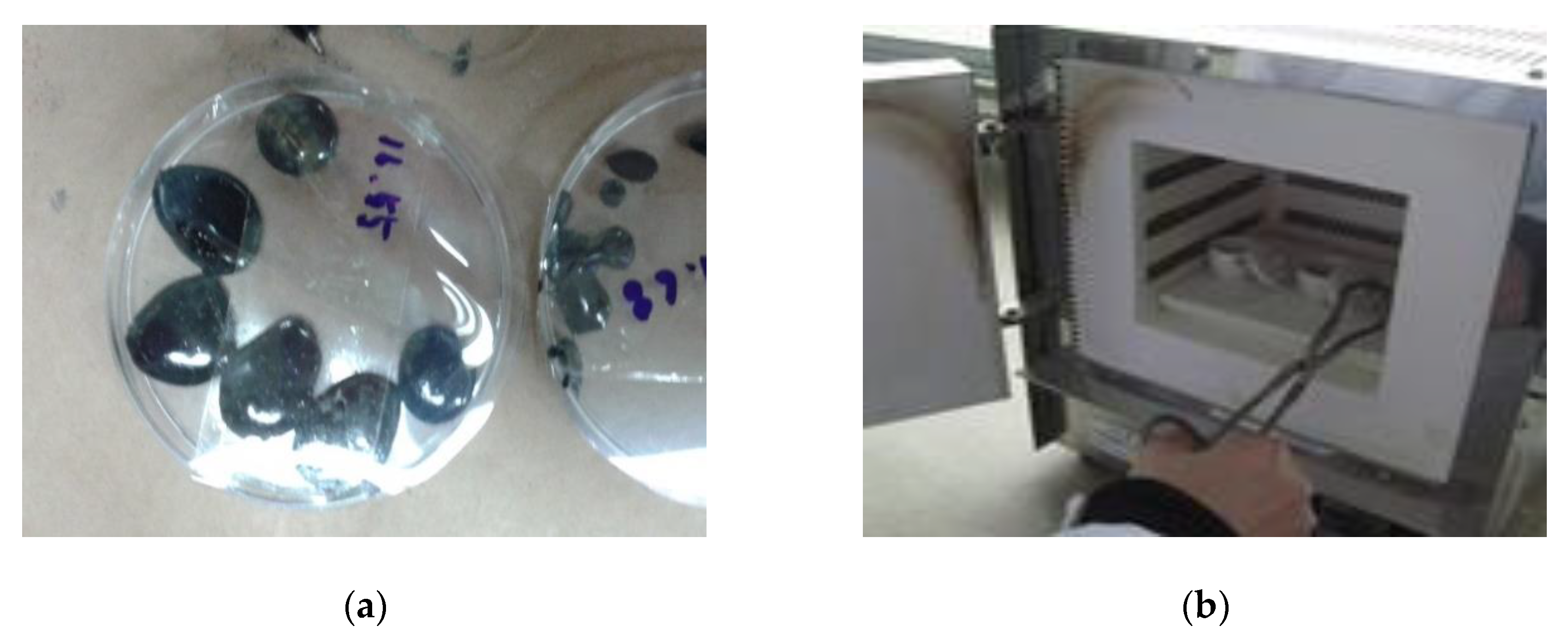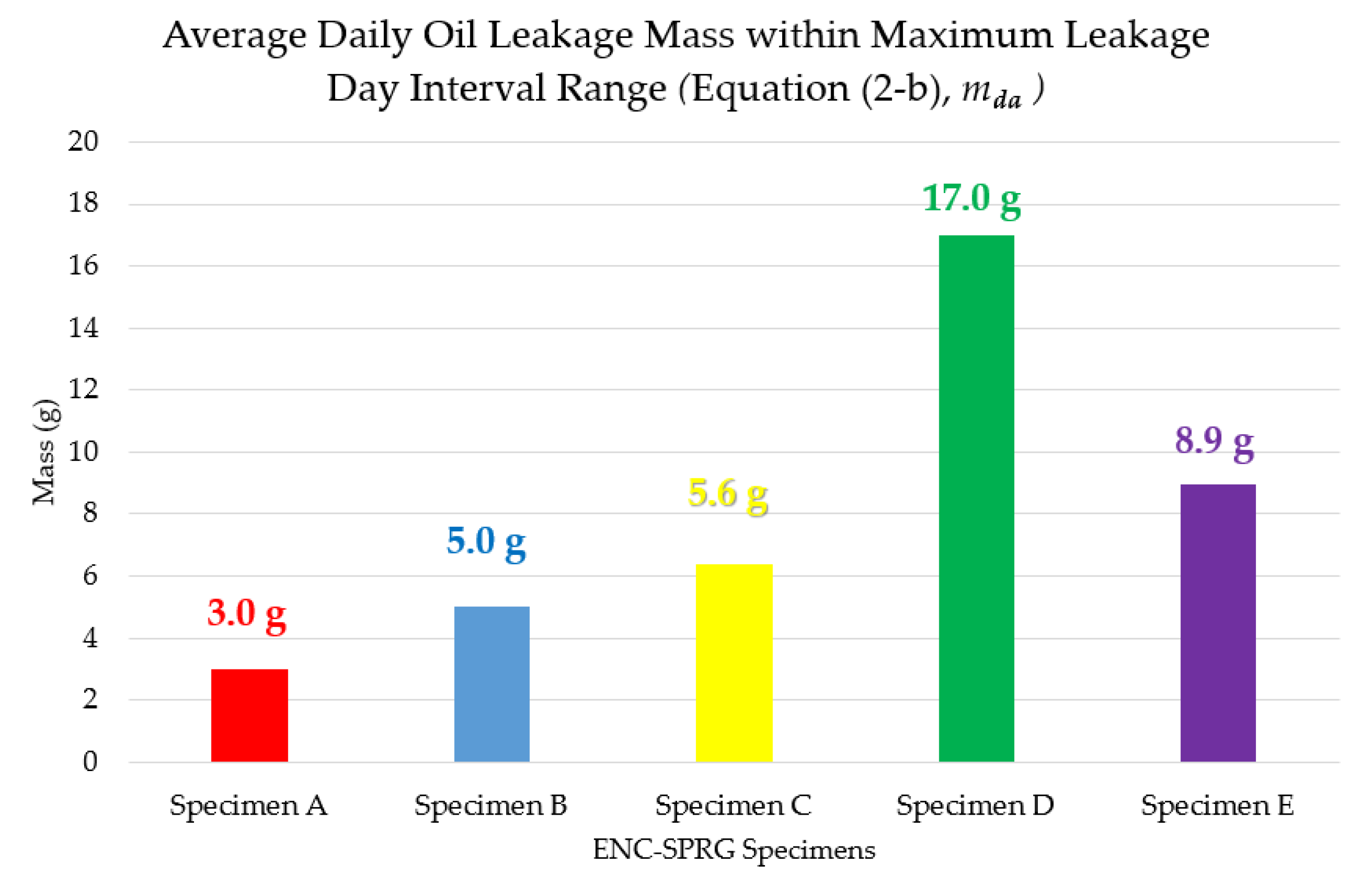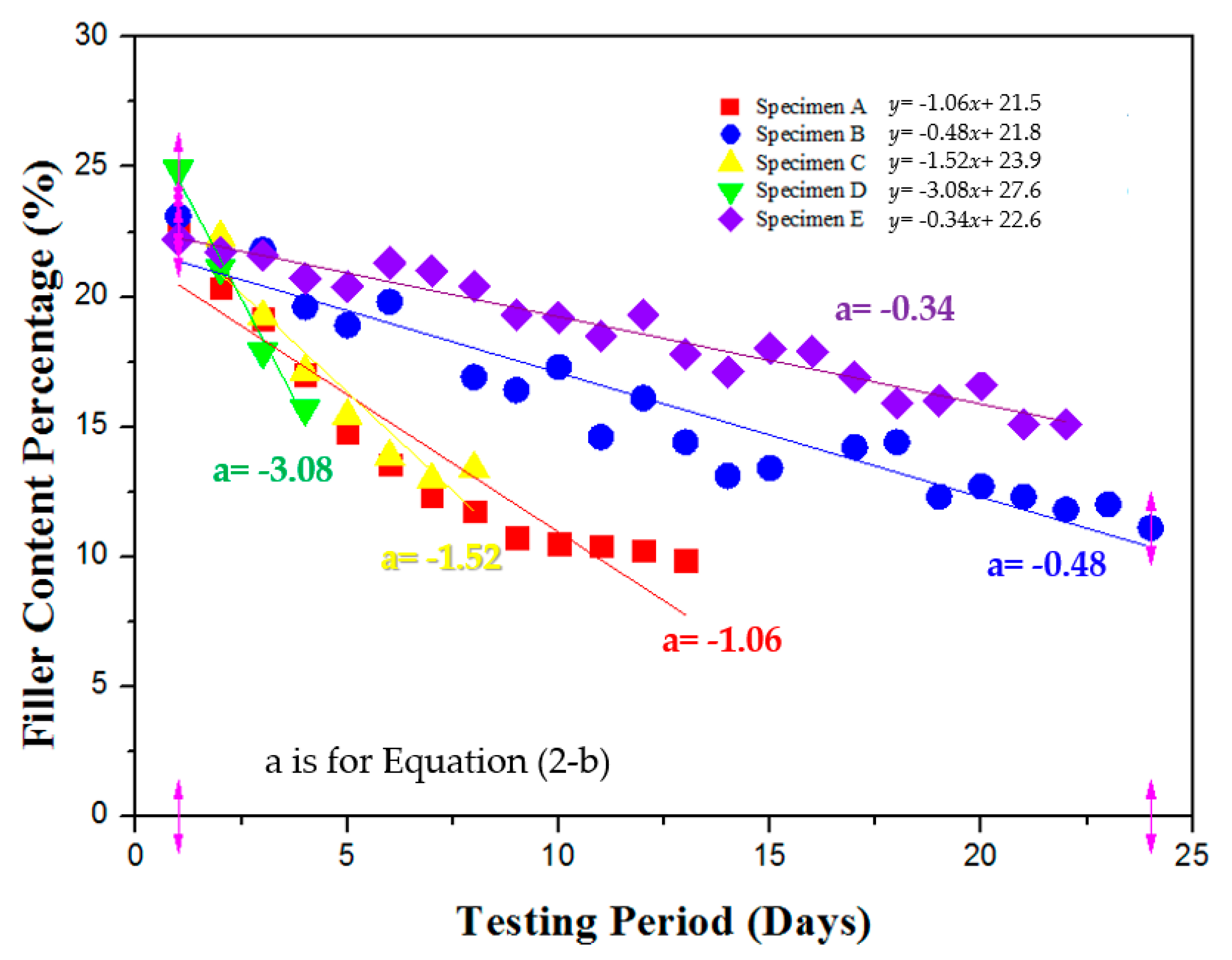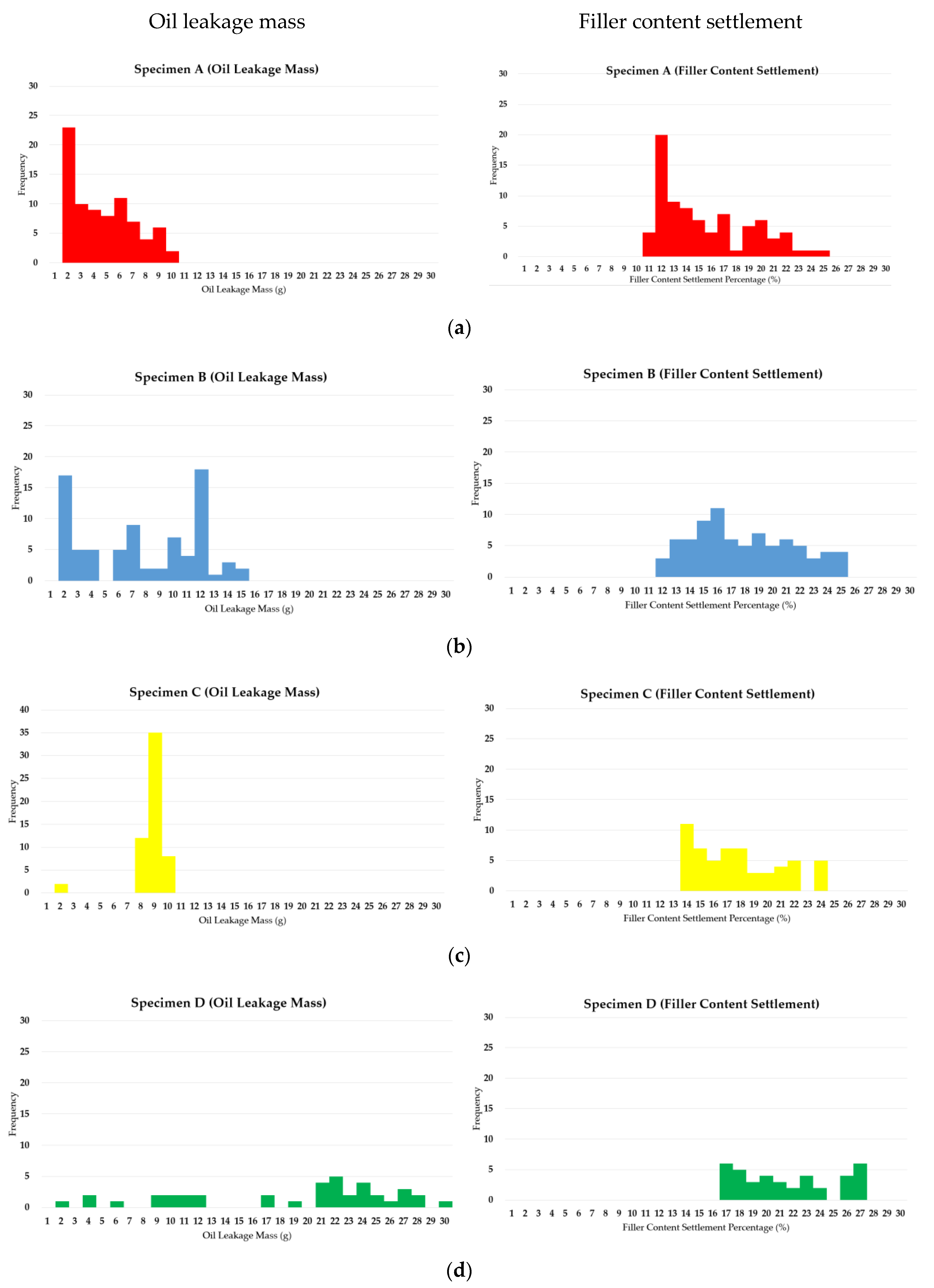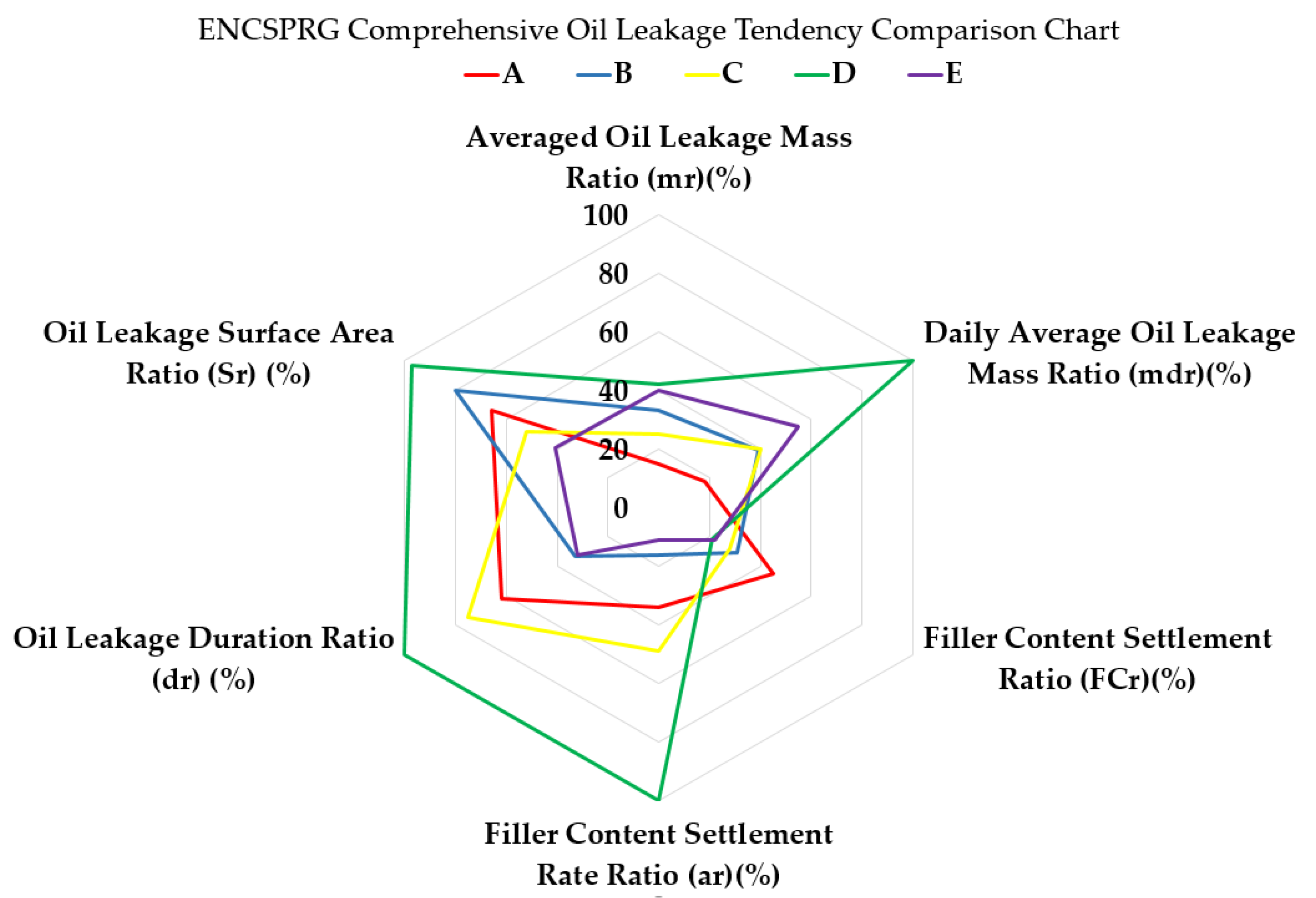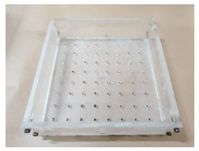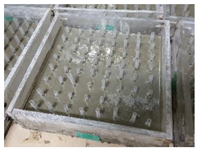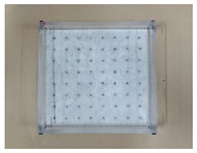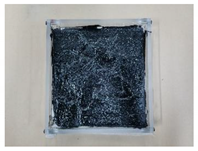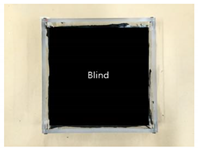Figure 1.
Previous ENC-SPRG evaluation specimen structure; (a) linear crack specimen, (b) limited observation of oil leakage.
Figure 1.
Previous ENC-SPRG evaluation specimen structure; (a) linear crack specimen, (b) limited observation of oil leakage.
Figure 2.
Illustration of oil leakage mechanism of ENC-SPRG in composite waterproofing systems.
Figure 2.
Illustration of oil leakage mechanism of ENC-SPRG in composite waterproofing systems.
Figure 3.
Concrete structure slab layer of ENC-SPRG waterproofing.
Figure 3.
Concrete structure slab layer of ENC-SPRG waterproofing.
Figure 4.
Proposed specimen structure, (a) base body dimensions, (b) completed specimen base.
Figure 4.
Proposed specimen structure, (a) base body dimensions, (b) completed specimen base.
Figure 5.
Load conditioning on specimen, (a) pressure load applied, (b) set in a temperature chamber.
Figure 5.
Load conditioning on specimen, (a) pressure load applied, (b) set in a temperature chamber.
Figure 6.
Oil Leakage observation and record; (a) oil leak collecting and mass measurement, (b) leaked surface area calculation illustrated.
Figure 6.
Oil Leakage observation and record; (a) oil leak collecting and mass measurement, (b) leaked surface area calculation illustrated.
Figure 7.
Filler content measurement; (a) leaked oil collection, (b) set in an electric furnace.
Figure 7.
Filler content measurement; (a) leaked oil collection, (b) set in an electric furnace.
Figure 8.
Averaged mass of the sums of leaked oil.
Figure 8.
Averaged mass of the sums of leaked oil.
Figure 9.
Average daily oil leakage mass of ENC-SPRG specimens.
Figure 9.
Average daily oil leakage mass of ENC-SPRG specimens.
Figure 10.
Filler content settlement rate linear regression analysis of ENC-SPRG.
Figure 10.
Filler content settlement rate linear regression analysis of ENC-SPRG.
Figure 11.
Normative distribution of the probability density calculation of the average oil leakage mass and filler content settlement ratio (left: oil leakage mass, right: filler content settlement); (a) specimen A, (b) specimen B, (c) specimen B, (d) specimen D, (e) specimen E.
Figure 11.
Normative distribution of the probability density calculation of the average oil leakage mass and filler content settlement ratio (left: oil leakage mass, right: filler content settlement); (a) specimen A, (b) specimen B, (c) specimen B, (d) specimen D, (e) specimen E.
Figure 12.
Comprehensive illustration of the evaluation results of the five ENC-SPRG specimens.
Figure 12.
Comprehensive illustration of the evaluation results of the five ENC-SPRG specimens.
Table 1.
General components of emulsion-based non-curable synthetic polymer rubberized gel (ENC-SPRG) (for example).
Table 1.
General components of emulsion-based non-curable synthetic polymer rubberized gel (ENC-SPRG) (for example).
| Components | Specific Gravity | Content Ratio (%) | Remarks |
|---|
| Solids | Asphalt (liquid type) | 1.3 | 40 | Organic additives |
| Process oil (liquid type) | 0.977 | 8 |
| Rubber (solid type) | 0.93 | 15 |
| Calcium carbonate (powder type) | 2.93 | 14 | Inorganic additives (filler content) |
| Natural minerals (powder type) | More than 2 | 11 |
| Other additives | More than 1 | 2 | - |
| Volatiles | Xylene (liquid type) | Less than 1 | 10 | - |
| Toluene (liquid type) |
| Other additives |
Table 2.
LH Construction issued Specification for Performance Standard of ENC-SPRG.
Table 2.
LH Construction issued Specification for Performance Standard of ENC-SPRG.
| Item | Unit | Quality Standards |
|---|
| 1. Solid content | % | >85.0 |
| 2. Ash content | % | <15.0 |
| 3. Flow Resistance | mm | Flow length <2.0 |
| 4. Alkali Resistance | - | No deformation |
| 5. Heat Resistance (60 °C) | - | No deformation |
| 6. Low Temp. Flexibility(−15 °C) | - | No deformation |
| 7. Moisture Content | % | <1.0% |
| 8. Adhesion | N/mm2 | >0.7 |
| 9. Storage Stability | % | Solidity difference within 5% |
Table 3.
Five ENC-SPRG specimen properties.
Table 3.
Five ENC-SPRG specimen properties.
| Criteria | Performance Criteria | Product Labels (Specimen) |
|---|
| A | B | C | D | E |
|---|
| Solidity (%) | >70.0 | 78.0 | 77.8 | 76.7 | 72.1 | 75.3 |
| Filler Content* (%) | >15.0 < 30.0 | 25.8 | 24.2 | 22.5 | 25.2 | 23.5 |
| Viscosity (cp) | Brookfield 20 °C Specimen 6
1 rpm, 1 min | 340,000 | 420,000 | 350,000 | 346,000 | 430,333 |
Table 4.
Specimen assembly process.
Table 4.
Specimen assembly process.
| Step | Illustration | Explanation |
|---|
| 1 | ![Materials 12 03816 i001]() | (1) Mold work: Pretreated and fabricated acrylic mold prepared with the leakage outlet holes. For the leakage holes, the allocation of the holes is set to 8 × 8 with 64 holes in total and a 30 mm interval in between the holes. For the convenience of manufacturing, the diameter of the drilling tool was manufactured to Ø9~10 mm, which is included in the tolerance range. |
| 2 | ![Materials 12 03816 i002]() | (2) Leakage hole work: Leakage outlet hole molds are prepared by inserting cylindrical tubes (Ø8 × 35 mm) into the acrylic mold holes, and the bottom mortar substrate part is cast. After the substrate layer is cured, the cylindrical tubes are removed. |
| 3 | ![Materials 12 03816 i003]() | (3) Mortar substrate work: A non-woven fabric of 30 g/m2 was fixed on the top of a 270 × 270 mm mortar substrate (T: 30 mm) with Ø8 mm holes spaced at 30 mm intervals (for preventing excess, ENC-SPRG material flow out during ENC-SPRG installation). |
| 4 | ![Materials 12 03816 i004]() | (4) Primer and ENC-SPRG applying: primer is applied evenly at 0.3 kg/m2 and cured, and ENC-SPRG application is followed in compliance with the manufacturer specification (either by trowel, brush, metal spatula, or other tools), but the installed mass is fixed to be 160 g (thickness of the ENC-SPRG layer varies, but usually complies to 2 mm). |
| 5 | ![Materials 12 03816 i005]() | (5) Protection membrane installation; After ENC-SPRG specimen is installed, the protection waterproofing sheet is installed to form a composite waterproofing structure. |
| 6 | ![Materials 12 03816 i006]() | (6) Protection mortar casting; 30 mm thick upper mortar substrate layer (1:3 w/c content) is cast. Specimen curing; specimen is cured for 72 h (for creating enclosed condition). |
Table 5.
Oil leakage mass measurement result (specimen A).
Table 5.
Oil leakage mass measurement result (specimen A).
| | Days | 1 | 2 | 3 | 4 | 5 | 6 | 7 | 8 | 9 | 10 | 11 | 12 | 131* | 14 | 15 | 16 | 17 | 18 | 19 | 20 | 21 | 22 | 23 | 24 | 25 | Mass Sum (g) | Avg. (g) | Avg. Days |
|---|
| Samples | |
|---|
| A | 1 | - | 6.9 | 5.2 | 3.2 | 1.2 | 0.2 | 0.1 | 0.1 | - | - | - | - | - | - | - | - | - | - | - | - | - | - | - | - | - | 16.9 | 24.22* | 7 |
| 2 | - | - | - | 7.3 | 6.2 | 4.5 | 3.2 | 1.2 | 0.3 | 0.2 | - | - | - | - | - | - | - | - | - | - | - | - | - | - | - | 22.9 | 7 |
| 3 | - | - | - | - | 5.8 | 4.5 | 4.0 | 3.1 | 1.2 | 0.9 | 0.5 | 0.2 | - | - | - | - | - | - | - | - | - | - | - | - | - | 20.2 | 8 |
| 4 | - | - | - | 7.2 | 5.2 | 3.2 | 2.5 | 2.1 | 1.2 | 0.6 | 0.12 | 0.1 | - | - | - | - | - | - | - | - | - | - | - | - | - | 22.2 | 9 |
| 5 | 8.8 | 7.6 | 5.3 | 4.2 | 2.8 | 0.1 | - | - | - | - | - | - | - | - | - | - | - | - | - | - | - | - | - | - | - | 28.8 | 6 |
| 6 | - | 7.6 | 7.1 | 5.1 | 4.5 | 3.9 | 2.8 | 2.5 | 1.52 | 1.05 | 0.52 | 0.2 | - | - | - | - | - | - | - | - | - | - | - | - | - | 36.8 | 11 |
| 7 | - | 6.6 | 5.5 | 4.1 | 4.1 | 2.1 | 1.5 | 0.9 | - | - | - | - | - | - | - | - | - | - | - | - | - | - | - | - | - | 24.8 | 7 |
| 8 | - | - | - | - | 5.2 | 4.1 | 4.1 | 2.1 | 1.6 | 0.6 | 0.4 | 0.2 | 0.1 | - | - | - | - | - | - | - | - | - | - | - | - | 18.4 | 9 |
| 9 | - | - | 5.0 | 4.1 | 3.1 | 3.5 | 2.1 | 1.4 | 0.5 | - | - | - | - | - | - | - | - | - | - | - | - | - | - | - | - | 19.7 | 7 |
| 10 | 8.1 | 7.1 | 6.2 | 4.6 | 2.1 | 1.5 | 0.8 | 0.4 | 0.1 | - | - | - | - | - | - | - | - | - | - | - | - | - | - | - | - | 30.9 | 9 |
| | Daily AVG | 8.5 | 7.2 | 5.7 | 5.0 | 4.0 | 2.8 | 2.3 | 1.5 | 0.9 | 0.7 | 0.4 | 0.2 | 0.1 | - | - | - | - | - | - | - | - | - | - | - | - | 39.33* | 3.04* | 85* |
Table 6.
Oil leakage mass measurement result (specimen B).
Table 6.
Oil leakage mass measurement result (specimen B).
| | Days | 1 | 2 | 3 | 4 | 5 | 6 | 7 | 8 | 9 | 10 | 11 | 12 | 13 | 14 | 15 | 16 | 17 | 18 | 19 | 20 | 21 | 22 | 23 | 241* | 25 | Mass Sum (g) | Avg. (g) | Avg. Days |
|---|
| Samples | |
|---|
| B | 1 | - | 12.5 | - | 13.5 | 5.2 | - | - | - | 4.3 | - | 5.2 | - | 0.5 | 1.5 | 2.0 | - | - | - | 0.5 | - | - | - | 0.2 | - | - | 45.4 | 52.62* | 10 |
| 2 | 13.2 | 12.8 | - | - | 8.4 | - | - | - | 10.2 | - | 10.8 | - | - | 0.1 | - | - | - | - | - | - | 0.8 | - | - | - | - | 56.3 | 7 |
| 3 | - | 12.9 | - | 10.4 | - | - | - | 10.2 | - | - | 8.5 | - | - | - | 1.6 | - | - | - | - | 0.7 | - | 0.2 | - | 5.3 | - | 49.8 | 8 |
| 4 | 8.2 | - | 10.3 | - | - | 10.6 | - | - | 1.5 | - | - | 5.2 | - | 4.2 | - | - | 4.2 | 4.1 | - | - | - | - | - | - | - | 48.3 | 8 |
| 5 | - | 10.5 | - | 13.0 | - | 10.5 | - | - | 5.6 | - | - | 5.2 | 4.2 | - | 0.3 | - | 0.2 | - | - | - | - | - | - | - | - | 49.5 | 8 |
| 6 | 6.6 | 10.6 | - | - | 13.5 | 10.9 | - | 2.6 | - | - | 5.2 | - | - | 0.6 | 0.4 | - | - | - | - | - | - | - | 0.2 | - | - | 50.6 | 9 |
| 7 | 9.7 | 8.5 | 7.5 | - | 10.3 | 5.2 | - | - | - | 10.5 | - | 2.3 | - | - | - | - | - | 0.3 | - | - | 0.5 | - | - | - | - | 54.8 | 9 |
| 8 | - | 10.5 | - | 10.2 | 8.9 | - | - | - | 7.4 | - | - | - | 8.9 | - | - | - | 8.6 | - | - | - | - | - | 0.1 | - | - | 54.6 | 7 |
| 9 | 11.1 | - | - | - | - | 13.2 | - | 10.5 | - | 10.5 | - | - | - | - | - | - | 9.6 | - | - | - | 2.1 | - | - | 0.2 | - | 57.2 | 7 |
| 10 | 9.5 | - | 10.6 | - | 9.9 | - | - | - | - | 5.6 | - | 10.4 | - | - | 2.6 | - | 6.6 | - | 2.3 | 1.2 | - | - | 0.5 | - | - | 59.2 | 10 |
| | Daily AVG | 9.7 | 11.2 | 9.5 | 11.8 | 9.4 | 10.1 | 0 | 7.8 | 5.8 | 8.9 | 7.4 | 5.8 | 4.5 | 1.6 | 1.4 | 0 | 5.8 | 2.2 | 1.4 | 1.0 | 1.1 | 0.2 | 0.2 | 2.7 | - | 119.53* | 5.04* | 85* |
Table 7.
Oil leakage mass measurement results (specimen C).
Table 7.
Oil leakage mass measurement results (specimen C).
| | Days | 1 | 2 | 3 | 4 | 5 | 6 | 7 | 81* | 9 | 10 | 11 | 12 | 13 | 14 | 15 | 16 | 17 | 18 | 19 | 20 | 21 | 22 | 23 | 24 | 25 | Mass Sum (g) | Avg. (g) | Avg. Days |
|---|
| Samples | |
|---|
| C | 1 | - | - | 7.8 | 7.3 | 7.1 | 7.9 | 8.0 | - | - | - | - | - | - | - | - | - | - | - | - | - | - | - | - | - | - | 38.1 | 40.32* | 5 |
| 2 | - | - | 6.9 | 7.8 | 7.5 | 7.2 | 7.0 | - | - | - | - | - | - | - | - | - | - | - | - | - | - | - | - | - | - | 36.4 | 5 |
| 3 | - | 7.5 | 6.2 | 8.6 | 7.6 | 7.1 | 7.1 | - | - | - | - | - | - | - | - | - | - | - | - | - | - | - | - | - | - | 44.1 | 6 |
| 4 | - | - | 6.1 | 7.1 | 7.4 | 8.3 | 7.4 | - | - | - | - | - | - | - | - | - | - | - | - | - | - | - | - | - | - | 36.3 | 5 |
| 5 | - | - | 7.4 | 7.2 | 6.9 | 7.9 | 7.1 | - | - | - | - | - | - | - | - | - | - | - | - | - | - | - | - | - | - | 36.5 | 5 |
| 6 | - | 8.9 | 7.2 | 7.1 | 7.31 | 7.8 | 7.2 | 0.13 | - | - | - | - | - | - | - | - | - | - | - | - | - | - | - | - | - | 45.6 | 7 |
| 7 | - | - | 7.1 | 7.1 | 7.04 | 6.5 | 8.1 | 0.10 | - | - | - | - | - | - | - | - | - | - | - | - | - | - | - | - | - | 35.9 | 6 |
| 8 | - | 8.1 | 7.2 | 7.2 | 7.03 | 6.5 | 7.2 | - | - | - | - | - | - | - | - | - | - | - | - | - | - | - | - | - | - | 43.2 | 6 |
| 9 | - | 8.2 | 7.1 | 6.5 | 7.49 | 7.1 | 6.5 | - | - | - | - | - | - | - | - | - | - | - | - | - | - | - | - | - | - | 42.9 | 6 |
| 10 | - | 8.9 | 7.0 | 6.8 | 7.18 | 7.2 | 7.1 | - | - | - | - | - | - | - | - | - | - | - | - | - | - | - | - | - | - | 44.2 | 6 |
| | Daily AVG | 0 | 8.3 | 7.0 | 7.3 | 7.3 | 7.4 | 7.3 | 0.1 | - | - | - | - | - | - | - | - | - | - | - | - | - | - | - | - | - | 44.73* | 5.64* | 65* |
Table 8.
Oil leakage mass measurement result (specimen D).
Table 8.
Oil leakage mass measurement result (specimen D).
| | Days | 1 | 2 | 3 | 41* | 5 | 6 | 7 | 8 | 9 | 10 | 11 | 12 | 13 | 14 | 15 | 16 | 17 | 18 | 19 | 20 | 21 | 22 | 23 | 24 | 25 | Mass Sum (g) | Avg. (g) | Avg. Days |
|---|
| Samples | |
|---|
| D | 1 | 19.9 | 21.0 | 10.6 | - | - | - | - | - | - | - | - | - | - | - | - | - | - | - | - | - | - | - | - | - | - | 51.5 | 67.42* | 3 |
| 2 | 21.9 | 22.6 | 15.3 | 10.1 | - | - | - | - | - | - | - | - | - | - | - | - | - | - | - | - | - | - | - | - | - | 69.9 | 4 |
| 3 | 23.0 | 22.0 | 15.1 | 8.1 | - | - | - | - | - | - | - | - | - | - | - | - | - | - | - | - | - | - | - | - | - | 68.2 | 4 |
| 4 | 19.1 | 20.1 | 19.5 | 7.2 | - | - | - | - | - | - | - | - | - | - | - | - | - | - | - | - | - | - | - | - | - | 65.9 | 4 |
| 5 | 21.0 | 22.2 | 17.6 | 9.8 | - | - | - | - | - | - | - | - | - | - | - | - | - | - | - | - | - | - | - | - | - | 70.6 | 4 |
| 6 | 26.5 | 26.0 | 9.9 | 8.2 | - | - | - | - | - | - | - | - | - | - | - | - | - | - | - | - | - | - | - | - | - | 70.6 | 4 |
| 7 | 19.5 | 25.6 | 20.5 | 4.7 | - | - | - | - | - | - | - | - | - | - | - | - | - | - | - | - | - | - | - | - | - | 70.3 | 4 |
| 8 | 28.8 | 25.5 | 2.2 | 0.3 | - | - | - | - | - | - | - | - | - | - | - | - | - | - | - | - | - | - | - | - | - | 56.8 | 4 |
| 9 | 24.8 | 23.5 | 23.5 | 7.6 | - | - | - | - | - | - | - | - | - | - | - | - | - | - | - | - | - | - | - | - | - | 79.4 | 4 |
| 10 | 26.5 | 20.6 | 21.5 | 2.6 | - | - | - | - | - | - | - | - | - | - | - | - | - | - | - | - | - | - | - | - | - | 71.2 | 4 |
| | Daily AVG | 23.1 | 22.9 | 15.6 | 6.5 | - | - | - | - | - | - | - | - | - | - | - | - | - | - | - | - | - | - | - | - | - | 68.13* | 17.03* | 45* |
Table 9.
Oil leakage mass measurement result (specimen E).
Table 9.
Oil leakage mass measurement result (specimen E).
| | Days | 1 | 2 | 3 | 4 | 5 | 6 | 7 | 8 | 9 | 10 | 11 | 12 | 13 | 14 | 15 | 16 | 17 | 18 | 19 | 20 | 21 | 221* | 23 | 24 | 25 | Mass Sum (g) | Avg. (g) | Avg. Days |
|---|
| Samples | |
|---|
| E | 1 | - | - | - | - | 10.6 | - | - | - | 8.9 | 7.1 | - | 10.1 | - | 11.4 | - | - | 8.9 | - | - | - | - | - | - | - | - | 57.0 | 64.12* | 6 |
| 2 | - | - | - | 10.5 | - | - | 9.8 | - | 8.5 | 7.5 | - | - | 7.5 | - | - | - | - | 9.5 | - | - | - | 9.8 | - | - | - | 63.0 | 7 |
| 3 | - | 8.8 | - | - | - | 10.4 | - | 11.4 | - | - | - | 9.1 | - | - | - | 8.1 | - | - | 9.8 | - | - | - | - | - | - | 57.6 | 6 |
| 4 | - | - | 9.5 | - | - | 11.2 | - | 10.4 | - | - | 9.4 | - | 8.7 | - | - | - | - | 2.3 | - | - | - | 10.4 | - | - | - | 61.9 | 7 |
| 5 | - | - | 8.2 | - | 10.0 | - | - | 10.7 | - | - | - | - | 8.8 | - | - | - | 8.3 | - | - | - | 10.7 | - | - | - | - | 56.7 | 6 |
| 6 | - | 9.6 | - | - | - | 11.5 | - | - | 10.2 | - | - | 12.4 | - | - | 3.5 | - | - | 6.3 | - | - | 12.5 | - | - | - | - | 66.0 | 7 |
| 7 | 1.5 | 15.2 | - | - | 10.5 | - | - | - | 12.1 | - | - | - | 9.1 | - | - | 8.9 | - | - | 10.8 | - | - | 5.6 | - | - | - | 73.7 | 8 |
| 8 | - | 8.9 | 10.5 | 11.5 | 8.8 | - | - | - | - | 6.5 | - | - | - | - | 3.4 | - | - | - | - | 8.7 | - | 11.1 | - | - | - | 69.3 | 8 |
| 9 | - | 10.2 | - | 11.5 | - | 6.5 | - | - | 8.8 | - | - | 12.5 | - | - | - | 10.1 | - | - | 11.6 | - | - | - | - | - | - | 71.2 | 7 |
| 10 | - | 11.4 | - | - | 10.5 | - | - | 6.8 | - | - | 7.8 | - | - | 11.5 | - | - | - | 8.2 | - | - | - | 8.8 | - | - | - | 64.9 | 7 |
| | Daily AVG | 1.5 | 10.7 | 9.4 | 11.1 | 10.1 | 9.9 | 9.8 | 9.8 | 9.7 | 7.0 | 8.6 | 11.0 | 8.5 | 11.4 | 3.5 | 9.0 | 8.6 | 6.6 | 10.7 | 8.7 | 11.6 | 9.1 | - | - | - | 196.33* | 8.94* | 75* |
Table 10.
Averaged oil leakage mass and average daily oil leakage mass ratio calculation results.
Table 10.
Averaged oil leakage mass and average daily oil leakage mass ratio calculation results.
| Specimen | Averaged Oil Leakage Mass Ratio | Average Daily Oil Leakage Mass Ratio |
|---|
| Averaged Oil Leakage Mass (mc) (g) | Ratio (Equation (1-a), mt = 160 g) (mr) (%) | Mass of Leaked Oil Averaged at a Daily Basis (md) (g) | Last Leakage Day (dt in Equation (3)) | Expected Average Daily Oil Leakage Mass (mda) (g) | Ratio Calculation (Equation (1-c)) (mdr) (%) |
|---|
| A | 24.2 | 15 | 39.3 | 13 | 3.0 | 18 |
| B | 52.6 | 33 | 119.5 | 24 | 5.0 | 29 |
| C | 40.3 | 25 | 44.7 | 8 | 5.6 | 32 |
| D | 67.4 | 42 | 68.1 | 4 | 17.0 (highest mass) | 100 |
| E | 64.1 | 40 | 196.3 | 22 | 8.9 | 52 |
Table 11.
Filler content measurement result (specimen A).
Table 11.
Filler content measurement result (specimen A).
| | Days | 1 | 2 | 3 | 4 | 5 | 6 | 7 | 8 | 9 | 10 | 11 | 12 | 13 | 14 | 15 | 16 | 17 | 18 | 19 | 20 | 21 | 22 | 23 | 24 | 25 | Fc% | Avg. (%) |
|---|
| Samples | |
|---|
| A | 1 | - | 20.5 | 18.9 | 17.2 | 15.8 | 12.6 | 12.3 | 12.8 | - | - | - | - | - | - | - | - | - | - | - | - | - | - | - | - | - | 15.7 | 14.11* |
| 2 | - | - | - | 15.3 | 13.0 | 11.2 | 10.5 | 10.1 | 10.1 | 10.0 | - | - | - | - | - | - | - | - | - | - | - | - | - | - | - | 11.5 |
| 3 | - | - | - | - | 11.8 | 11.0 | 10.6 | 10.4 | 10.5 | 10.3 | 10.3 | 10.3 | - | - | - | - | - | - | - | - | - | - | - | - | - | 10.7 |
| 4 | - | - | - | 15.2 | 14.0 | 13.6 | 11.0 | 11.1 | 11.0 | 10.8 | 10.5 | 10.2 | - | - | - | - | - | - | - | - | - | - | - | - | - | 11.9 |
| 5 | 23.1 | 21.2 | 19.6 | 17.2 | 15.3 | 14.6 | - | - | - | - | - | - | - | - | - | - | - | - | - | - | - | - | - | - | - | 18.5 |
| 6 | - | 19.2 | 18.8 | 18.5 | 16.2 | 13.5 | 13.2 | 12.4 | 11.7 | 11.2 | 10.9 | 10.5 | - | - | - | - | - | - | - | - | - | - | - | - | - | 14.2 |
| 7 | - | 20.2 | 20.2 | 18.6 | 17.6 | 17.4 | 15.5 | 14.2 | - | - | - | - | - | - | - | - | - | - | - | - | - | - | - | - | - | 17.7 |
| 8 | - | - | - | - | 13.6 | 13 | 12.02 | 10.5 | 10.5 | 10.11 | 9.9 | 9.8 | 9.7 | - | - | - | - | - | - | - | - | - | - | - | - | 11.0 |
| 9 | - | - | 18.2 | 15.9 | 13.1 | 13.0 | 11.6 | 11.5 | 10.2 | - | - | - | - | - | - | - | - | - | - | - | - | - | - | - | - | 13.4 |
| 10 | 22.6 | 20.6 | 19.2 | 18.2 | 17.2 | 15.6 | 14.5 | 12.5 | 11.0 | - | - | - | - | - | - | - | - | - | - | - | - | - | - | - | - | 16.8 |
| | Daily AVG2* | 22.9 | 20.3 | 19.2 | 17.0 | 14.8 | 13.6 | 12.4 | 11.7 | 10.7 | 10.5 | 10.4 | 10.2 | 9.7 | - | - | - | - | - | - | - | - | - | - | - | - | - | |
Table 12.
Filler content measurement result (specimen B).
Table 12.
Filler content measurement result (specimen B).
| | Days | 1 | 2 | 3 | 4 | 5 | 6 | 7 | 8 | 9 | 10 | 11 | 12 | 13 | 14 | 15 | 16 | 17 | 18 | 19 | 20 | 21 | 22 | 23 | 24 | 25 | Fc% | Avg. (%) |
|---|
| Samples | |
|---|
| B | 1 | - | 22.2 | - | 19.5 | 18.5 | - | - | - | 15.2 | - | 14.3 | - | 13.0 | 12.1 | 11.6 | - | - | - | 11.2 | - | - | - | 11.0 | - | - | 14.9 | 16.71* |
| 2 | 23.0 | 22.2 | - | - | 17.5 | - | - | - | 14.8 | - | 13.3 | - | - | 11.9 | - | - | - | - | - | - | 10.9 | - | - | - | - | 16.2 |
| 3 | - | 20.7 | - | 17.9 | - | - | - | 15.6 | - | - | 14.3 | - | - | - | 12.7 | - | - | - | - | 12.2 | - | 11.8 | - | 11.3 | - | 14.6 |
| 4 | 23.5 | - | 21.6 | - | - | 19.8 | - | - | 17.2 | - | - | 15.8 | - | 15.1 | - | - | 14.6 | 14.8 | - | - | - | - | - | - | - | 17.8 |
| 5 | - | 23.8 | - | 22.3 | - | 20.9 | - | - | 18.5 | - | - | 15.4 | 14.8 | - | 14.4 | - | 13.7 | - | - | - | - | - | - | - | - | 18.0 |
| 6 | 21.9 | 21.6 | - | - | 20.0 | 18.6 | - | 17.6 | - | - | 16.5 | - | - | 13.1 | 13.5 | - | - | - | - | - | - | - | 10.9 | - | - | 17.1 |
| 7 | 23.6 | 23.1 | 22.9 | - | 20.2 | 19.9 | - | - | - | 18.2 | - | 16.8 | - | - | - | - | - | 14.1 | - | - | 13.3 | - | - | - | - | 19.1 |
| 8 | - | 20.8 | - | 18.6 | 17.8 | - | - | - | 16.3 | - | - | - | 15.5 | - | - | - | 15.0 | - | - | - | - | - | 13.7 | - | - | 16.8 |
| 9 | 23.1 | - | - | - | - | 19.8 | - | 17.3 | - | 16.6 | - | - | - | - | - | - | 13.5 | - | - | - | 12.7 | - | - | 11.0 | - | 16.3 |
| 10 | 23.7 | - | 20.8 | - | 19.3 | - | - | - | - | 17.1 | - | 16.4 | - | - | 14.7 | - | 14.1 | - | 13.4 | 13.3 | - | - | 12.3 | - | - | 16.5 |
| | Daily AVG2* | 23.1 | 22.1 | 21.8 | 19.6 | 18.9 | 19.8 | - | 16.8 | 16.4 | 17.3 | 14.6 | 16.1 | 14.4 | 13.1 | 13.4 | - | 14.2 | 14.5 | 12.3 | 12.8 | 12.3 | 11.8 | 12.0 | 11.2 | - | - | |
Table 13.
Filler content measurement result (specimen C).
Table 13.
Filler content measurement result (specimen C).
| | Days | 1 | 2 | 3 | 4 | 5 | 6 | 7 | 8 | 9 | 10 | 11 | 12 | 13 | 14 | 15 | 16 | 17 | 18 | 19 | 20 | 21 | 22 | 23 | 24 | 25 | Fc% | Avg. (%) |
|---|
| Samples | |
|---|
| C | 1 | - | - | 20.8 | 16.3 | 15.5 | 13.4 | 12.9 | - | - | - | - | - | - | - | - | - | - | - | - | - | - | - | - | - | - | 15.8 | 16.21* |
| 2 | - | - | 16.2 | 16.2 | 14.8 | 12.2 | 12.2 | - | - | - | - | - | - | - | - | - | - | - | - | - | - | - | - | - | - | 14.3 |
| 3 | - | 22.4 | 18.8 | 15.3 | 13.2 | 12.7 | 12.1 | - | - | - | - | - | - | - | - | - | - | - | - | - | - | - | - | - | - | 15.8 |
| 4 | - | - | 20.8 | 19.1 | 16.3 | 16.1 | 14.2 | - | - | - | - | - | - | - | - | - | - | - | - | - | - | - | - | - | - | 17.3 |
| 5 | - | - | 19.9 | 17.8 | 15.7 | 14.8 | 12.3 | - | - | - | - | - | - | - | - | - | - | - | - | - | - | - | - | - | - | 16.1 |
| 6 | - | 22.2 | 18.4 | 18.3 | 14.5 | 13.1 | 13.0 | 12.8 | - | - | - | - | - | - | - | - | - | - | - | - | - | - | - | - | - | 16.0 |
| 7 | - | - | 20.2 | 20.0 | 19.1 | 16.6 | 15.6 | 14.0 | - | - | - | - | - | - | - | - | - | - | - | - | - | - | - | - | - | 17.6 |
| 8 | - | 22.3 | 19.7 | 15.5 | 13.2 | 12.8 | 12.1 | - | - | - | - | - | - | - | - | - | - | - | - | - | - | - | - | - | - | 15.9 |
| 9 | - | 22.5 | 20.3 | 17.2 | 16.8 | 13.3 | 12.1 | - | - | - | - | - | - | - | - | - | - | - | - | - | - | - | - | - | - | 17.0 |
| 10 | - | 22.1 | 17.2 | 15.4 | 15.1 | 13.4 | 13.2 | - | - | - | - | - | - | - | - | - | - | - | - | - | - | - | - | - | - | 16.1 |
| | Daily AVG2* | - | 22.3 | 19.2 | 17.1 | 15.4 | 13.8 | 13.0 | 13.4 | - | - | - | - | - | - | - | - | - | - | - | - | - | - | - | - | - | - | |
Table 14.
Filler content measurement result (specimen D).
Table 14.
Filler content measurement result (specimen D).
| | Days | 1 | 2 | 3 | 4 | 5 | 6 | 7 | 8 | 9 | 10 | 11 | 12 | 13 | 14 | 15 | 16 | 17 | 18 | 19 | 20 | 21 | 22 | 23 | 24 | 25 | Fc% | Avg. (%) |
|---|
| Samples | |
|---|
| D | 1 | 25.1 | 19.3 | 16.1 | - | - | - | - | - | - | - | - | - | - | - | - | - | - | - | - | - | - | - | - | - | - | 20.2 | 20.01* |
| 2 | 24.86 | 21.4 | 17.6 | 15.9 | - | - | - | - | - | - | - | - | - | - | - | - | - | - | - | - | - | - | - | - | - | 19.9 |
| 3 | 25.13 | 22.5 | 18.3 | 15.6 | - | - | - | - | - | - | - | - | - | - | - | - | - | - | - | - | - | - | - | - | - | 20.4 |
| 4 | 24.71 | 21.9 | 17.7 | 15.3 | - | - | - | - | - | - | - | - | - | - | - | - | - | - | - | - | - | - | - | - | - | 19.9 |
| 5 | 25.04 | 21.5 | 18.1 | 16.1 | - | - | - | - | - | - | - | - | - | - | - | - | - | - | - | - | - | - | - | - | - | 20.2 |
| 6 | 25.18 | 20.1 | 17.6 | 16.1 | - | - | - | - | - | - | - | - | - | - | - | - | - | - | - | - | - | - | - | - | - | 19.7 |
| 7 | 24.13 | 19.9 | 16.5 | 15.1 | - | - | - | - | - | - | - | - | - | - | - | - | - | - | - | - | - | - | - | - | - | 18.9 |
| 8 | 25.11 | 22.1 | 19.6 | 15.5 | - | - | - | - | - | - | - | - | - | - | - | - | - | - | - | - | - | - | - | - | - | 20.6 |
| 9 | 24.92 | 20.7 | 18.5 | 16.7 | - | - | - | - | - | - | - | - | - | - | - | - | - | - | - | - | - | - | - | - | - | 20.2 |
| 10 | 25.18 | 21.1 | 18.4 | 15.1 | - | - | - | - | - | - | - | - | - | - | - | - | - | - | - | - | - | - | - | - | - | 19.9 |
| | Daily AVG2* | 24.9 | 21.1 | 17.8 | 15.7 | - | - | - | - | - | - | - | - | - | - | - | - | - | - | - | - | - | - | - | - | - | - | |
Table 15.
Filler content measurement result (specimen E).
Table 15.
Filler content measurement result (specimen E).
| | Days | 1 | 2 | 3 | 4 | 5 | 6 | 7 | 8 | 9 | 10 | 11 | 12 | 13 | 14 | 15 | 16 | 17 | 18 | 19 | 20 | 21 | 22 | 23 | 24 | 25 | Fc% | Avg. (%) |
|---|
| Samples | |
|---|
| E | 1 | - | - | - | - | 22.4 | - | - | - | 21.2 | 20.9 | - | 19.7 | - | 18.1 | - | - | 16.3 | - | - | - | - | - | - | - | - | 19.8 | 18.91* |
| 2 | - | - | - | 21.1 | - | - | 21.0 | - | 17.6 | 17.3 | - | - | 15.9 | - | - | - | - | 14.2 | - | - | - | 14.4 | - | - | - | 17.4 |
| 3 | - | 22.2 | - | - | - | 22.4 | - | 21.6 | - | - | - | 20.6 | - | - | - | 19.1 | - | - | 16.2 | - | - | - | - | - | - | 20.4 |
| 4 | - | - | 22.1 | - | - | 21.9 | - | 21.1 | - | - | 19.2 | - | 18.7 | - | - | - | - | 17.1 | - | - | - | 15.4 | - | - | - | 19.4 |
| 5 | - | - | 21.4 | - | 21.1 | - | - | 20.5 | - | - | - | - | 19.6 | - | - | - | 17.5 | - | - | - | 15.2 | - | - | - | - | 19.2 |
| 6 | - | 22.9 | - | - | - | 20.2 | - | - | 19.4 | - | - | 18.4 | - | - | 17.6 | - | - | 16.9 | - | - | 15.1 | - | - | - | - | 18.6 |
| 7 | 22.2 | 20.4 | - | - | 19.5 | - | - | - | 18.9 | - | - | - | 17.1 | - | - | 16.4 | - | - | 15.6 | - | - | 15.0 | - | - | - | 18.1 |
| 8 | - | 21.6 | 21.3 | 20.2 | 19.4 | - | - | - | - | 19.5 | - | - | - | - | 18.3 | - | - | - | - | 16.6 | - | 15.4 | - | - | - | 19.0 |
| 9 | - | 22.8 | - | 20.7 | - | 20.9 | - | - | 19.2 | - | - | 18.4 | - | - | - | 18.1 | - | - | 16.1 | - | - | - | - | - | - | 19.5 |
| 10 | - | 20.3 | - | - | 19.6 | - | - | 18.5 | - | - | 17.9 | - | - | 16.1 | - | - | - | 15.4 | - | - | - | 15.1 | - | - | - | 17.6 |
| | Daily AVG2* | 22.2 | 21.7 | 21.6 | 20.7 | 20.4 | 21.4 | 21.0 | 20.4 | 19.3 | 19.2 | 18.6 | 19.3 | 17.8 | 17.1 | 18.0 | 17.9 | 16.9 | 15.9 | 16.0 | 16.6 | 15.2 | 15.1 | - | - | - | - | |
Table 16.
Averaged oil leakage mass and average daily oil leakage mass ratio calculation results.
Table 16.
Averaged oil leakage mass and average daily oil leakage mass ratio calculation results.
| Specimen | Filler Content Settlement Ratio | Filler Content Settlement Rate Ratio |
|---|
| Averaged Filler Content of the Leaked Oil Mass (wa) (%) | Ratio (Equation (2-a), for w0 Refer to Table 3) (FCr) (%) | Slope from Linear Regression Analysis (a) | Ratio (Equation (2-c)) (ar) (%) |
|---|
| A | 14.1 | 45 | −1.06 | 34 |
| B | 16.7 | 31 | −0.48 | 16 |
| C | 16.2 | 28 | −1.52 | 49 |
| D | 20.0 | 21 | −3.08 (lowest slope) | 100 |
| E | 18.9 | 20 | −0.34 | 11 |
Table 17.
Oil leakage duration ratio calculation results.
Table 17.
Oil leakage duration ratio calculation results.
| Specimen | Number of Leakage Days (Avg.) (dn in Equation (3)) | Last Leakage Day (dt in Equation (3)) | Oil Leakage Duration Ratio (Equation (3)) (dr) (%) |
|---|
| A | 8 | 13 | 62 |
| B | 8 | 24 | 33 |
| C | 6 | 8 | 75 |
| D | 4 | 4 | 100 |
| E | 7 | 22 | 32 |
Table 18.
Average oil leakage surface area calculation results.
Table 18.
Average oil leakage surface area calculation results.
| Specimen | Number of Leakage Points (Avg.) (Sl) | Oil Leakage Surface Area Ratio (Equation (4)) (Sl/64 = Sr) (%) |
|---|
| A | 42 | 66 |
| B | 51 | 80 |
| C | 33 | 52 |
| D | 62 | 97 |
| E | 26 | 41 |
Table 19.
Ratio results of each evaluation criterion.
Table 19.
Ratio results of each evaluation criterion.
| Equation | (1-a) | (1-c) | (2-a) | (2-b) | (3) | (4) |
|---|
| Specimen | Averaged Oil Leakage Mass Ratio, mr (%) | Daily Average Oil Leakage Mass Ratio, mdr (%) | Filler Content Settlement Ratio, FCr (%) | Filler Content Settlement Rate Ratio, Slope ar (%) | Maximum Leakage Duration Range Ratio, dr (%) | Oil Leakage Surface Area Ratio, Sr (%) |
|---|
| A | 15 | 18 | 45 | 34 | 62 | 66 |
| B | 33 | 29 | 31 | 16 | 33 | 80 |
| C | 25 | 32 | 28 | 49 | 75 | 52 |
| D | 42 | 100 | 21 | 100 | 100 | 97 |
| E | 40 | 52 | 20 | 11 | 32 | 41 |


